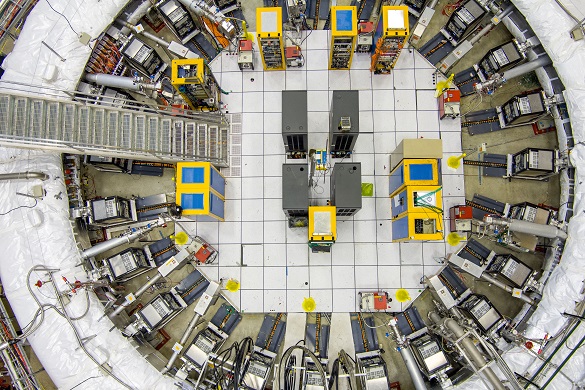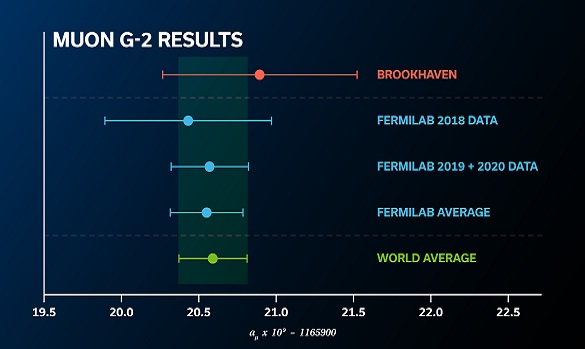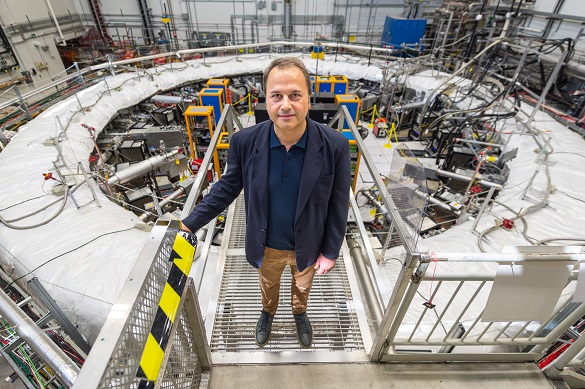
Photo: Ryan Postel, Fermilab
The University of Liverpool is at the forefront of a landmark announcement today (Thursday 10 August) by an international science experiment that takes a step closer to the discovery of new physics.
Liverpool researchers are part of the international team working on the Fermilab Muon g-2 experiment that has recorded the most precise measurement yet of the magnetic moment of the muon, entering a new realm in the search for new interactions that govern our Universe.
Their findings of the experiment are submitted today in the journal, Physical Review Letters.
This new measurement confirms the first results of the experiment announced in April 2021 but with more than a factor of two improvement in precision. The measurement has an uncertainty of 0.2 parts per million and is the most precise ever made using a particle accelerator.

Due to the large amount of additional data that is going into the 2023 analysis announcement, the Muon g-2 collaboration’s latest result is more than twice as precise as the first result announced in 2021. Image: Muon g-2 collaboration
Liverpool’s contribution
The Muon g-2 experiment is an international collaboration between Fermilab and dozens of labs and universities in seven countries, including the UK.
The University of Liverpool is part of the UK collaboration supporting the experiment that includes the universities of Lancaster, Manchester, UCL and the Cockcroft Institute.
Liverpool scientists provided important contributions to the experiment including analysis of the magnetic field and beam dynamics correction for the new result.
Professor Graziano Venanzoni, Leverhulme International Professor of Physics with the University of Liverpool’s Department of Physics, is one of two-spokespersons for the Muon g-2 experiment.

Professor Graziano Venanzoni
He said: “We have moved the accuracy bar of this experiment one step further and now we are waiting for the theory to complete the calculations and cross-checks necessary to reach the experimental accuracy. In the history of physics, the dialogue between experiment and theory has often been a competition between the two: sometimes the theory came first (as in the case of Dirac’s prediction of antimatter), other times the experiment came first (as in the case of measurements on atomic orbitals and the development of quantum mechanics).
“This competition advances our knowledge of the basics law of the nature. I am sure that this will also be true this time and the comparison between our measurement of the muon magnetic moment and theory prediction will lead to an extremely accurate test of the Standard Model theory of particle physics with a big impact on possible new physics scenarios.”
Liverpool particle physicist Professor Themis Bowcock provided expertise to the UK team that built the detector and electronics for the experiment.
He said: “Today’s result is confirmation of the importance of Liverpool’s contribution to the experiment. Our world class designers, engineers and workshop have played a crucial role in building a key component of g-2. This measurement, even a few years ago, would have unambiguously pointed to new physics. Now we know that a new generation of experiments (at CERN and elsewhere) and another level of theoretical development is required to interpret this result. It is either a revolution in physics or a major step forward in our knowledge of the quantum mechanics of “empty space” – the vacuum. Either way, it is an amazing leap into future where the Liverpool team will lead the way.”
Professor Thomas Teubner from the University’s Department of Mathematical Sciences is one of only two theoretical physicists working on the experiment.
He said: “What an incredible story of science at the precision frontier! As one of the two theorists in the Muon g-2 Collaboration, I have much enjoyed doing shifts during data taking and contributing to the new Run 2-3 results. They confirm the Run 1 measurement and have pushed the experimental precision to a new level… and the ball back in the camp of the theory community.
“Our Standard Model prediction of g-2 suffers from unforeseen and unresolved puzzles which, at this moment, prevent a firm conclusion. However, as part of the Muon g-2 Theory Initiative and with a growing team of theorists, the muon physics group in Liverpool is ideally placed to take on the challenge. The race is on to consolidate and improve the theory prediction in time for the final experimental result from FNAL in a few years from now.”
What are muons
Muons are fundamental particles that are similar to electrons but about 200 times heavier. Like electrons, muons have internal magnets that, in the presence of a magnetic field, cause them to ‘wobble’ like the axis of a spinning top.
The speed at which they ‘wobble’ in a given magnetic field depends on a property known as the magnetic moment of the muon, which is typically represented by the letter g. At the simplest level, theory predicts that g should equal 2. The difference of g from 2 — or g minus 2 — can be attributed to the muon’s interactions with particles in the quantum foam that surrounds it. As-yet-undiscovered particles can contribute to the value of g-2 opening a window to new subatomic phenomena.
With this latest measurement, the collaboration has already reached their goal of decreasing one particular type of uncertainty caused by experimental imperfections, known as systematic uncertainties.
While the total systematic uncertainty has already surpassed the design goal, the larger aspect of uncertainty known as statistical uncertainty is driven by the amount of data analysed. The experiment will reach its ultimate statistical uncertainty once scientists incorporate all six years of data in their analysis, which the collaboration aims to complete in the next couple of years.
The UK collaboration is supported by the UK Science and Technology Facilities Council (STFC), part of UK Research and Innovation (UKRI).
Find out more about this announcement by reading the article “Is there new physics beyond the Standard Model of particle physics? Our finding will help settle the question” which has been written by University of Liverpool researchers for `The Conversation’.
Fermilab is America’s premier national laboratory for particle physics research. For further information, visit Fermilab’s website.